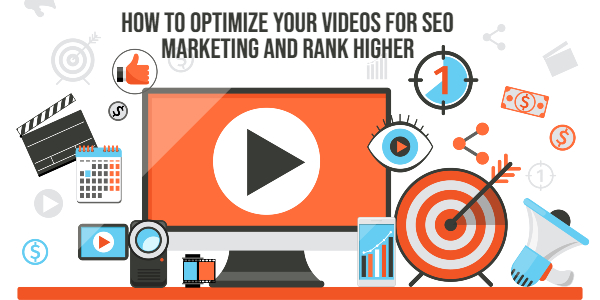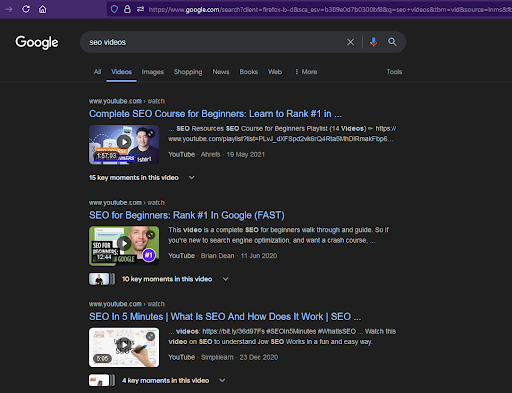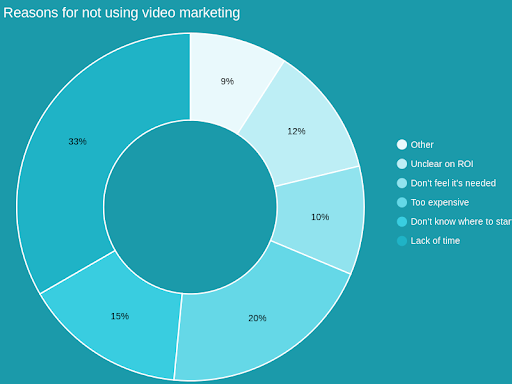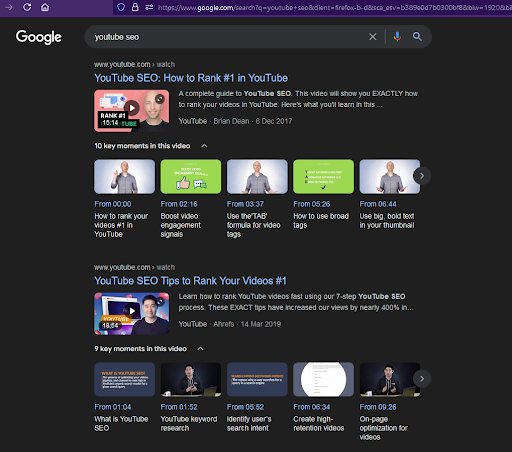
People in the digital marketing field are probably well aware of the term search engine optimization (SEO). However, many new digital marketers in this industry may not know how to use informative videos on websites and drive more people to them. So, practically, they didn’t know about Video SEO marketing and how to do it like a pro.
Video marketing is rapidly becoming one of the most important forms of content marketing. If you can do it properly, it may build your website’s presence in search engines and social media networks.
Before clarifying how Video SEO can boost your web presence and organic visitors and the techniques to implement it, let’s discuss a little more about what Video SEO Marketing actually is.
What Is Video SEO?

Over time, search engines discovered that people desire to watch video material, so they made it easy to find. Google not only provides a "video" tab but also features videos on the first page of SERPs. Video SEO (VSEO) is a way of attracting a larger audience and increasing video views through search engines like Google and social media platforms such as Facebook or Instagram.
It signifies optimizing your video content so that it ranks top when viewers use Google search for a specific query it addresses. Optimizing video content for SEO would also allow people to discover your material on social media platforms. Interesting videos on Instagram or Facebook have higher reach and engagement than simple text posts or images.
Why a Video SEO Strategy Is Important
There are several reasons:
Boosts Google SERP ranking for your web pages
Optimizing videos for your website can boost other metrics that Google may consider as their search engine ranking factors. SEO experts would agree that two of the most important metrics for SEO are “the time spent by users on your page or site” and the “number of backlinks” from other domains. Video SEO can boost both metrics significantly. According to the stats, on average, visitors of a website stay on pages about 1.4x more time with videos, compared with text pages. Good, informative videos not only attract more visitors but also provide high-quality backlinks.
So, video SEO works for your SERP ranking, and it influences other factors that help your ranking. Practically, Google is focusing on websites that include videos on their pages. With good video content comes new information. 93% of online experiences start with a search engine. So, you must include videos that may help you reach your web pages on the SERP's first page.
Increases web visibility for your entire domain
Google and YouTube are the most visited websites in the world. Almost every organization wants to promote its brands on them.
With a solid Video SEO plan, you can fulfill several ranking algorithms for these two websites. Your optimized videos may boost your website and give it a better shot at ranking higher in SERPs. The higher the rank you get for your videos, the more you’re reaching your target audience. It will drive them to your website and promote your brand.
Boosts user experience (UX)
You can use the Video SEO method and incorporate the right keywords into your page. This will make your pages more relevant to the visitor's search intent. You can also create videos and use them to increase your site's overall user experience (UX).
UX is the total quality of user experience rendered from a service, product, or media. You should add video content to your page that is interesting and engaging. If your videos convey relevant information effectively, you'll probably achieve a great UX.
You may analyze the UX of your video content with a few engagement metrics:
- Time spent by users
- Likes
- Comments
- Shares
- Click-through rate (CTR)
Increase your conversion rate
If you can do it properly, a video SEO strategy may help you generate more revenue through higher conversions. It is all about giving your visitors the proper reason to convert. By using videos, you should provide the correct information as per the user search intent. This way you can drive the right visitors to your page. When your visitors find the information for their queries, they will happily convert. This way, you’ll get a steady number of users and can generate revenue.
Reasons SEO Experts Hesitate Using Video Marketing

Data courtesy - wyzowl.com
- Lack of time - 33% of marketers do not use video marketing strategy due to lack of time.
- Higher costs - 20% of marketers who do not use video marketing claim it is prohibitively expensive.
- Lack of awareness - 15% of marketers who don't use video marketing aren't sure where to begin.
- Return over investment - 12% of marketers who do not utilize video marketing are unsure about the ROI of video marketing.
- Ignorance - 10% of marketers who do not use video marketing believe they don't need this approach.
- Others - 9% of marketers who do not use video marketing have other reasons.
However, 68% of marketers who don't use video marketing admitted that they are planning to use video SEO marketing in 2024.
Is it worth optimizing videos on YouTube?

As an SEO expert, you should always optimize your video content on YouTube. This will give you the same result as optimizing your web pages for higher search engine rankings and more visitors. Google owns YouTube. So, highly optimized YouTube videos rank high in Google search results and get more views, clicks, and conversions. Google says websites must optimize their multiple videos to boost visibility and user engagement.
You should optimize your videos in a way so that you can solve the queries of your prospective users. Doing that will fulfill 90% of your YouTube SEO work.
Posting big articles on your website might be a challenging job. You can’t just publish a lengthy 2500 to 3000 words article. It will take a lot of hard work and research to write that. And there is no guarantee that readers will read such a massive post. But, if you can create a YouTube video on the same topic and make it optimized, it may work better. Visitors may prefer watching that 5 to 10-minute video rather than reading a big blog post. This strategy can actually increase your viewer engagement time and reduce the bounce rate.
This is the sole reason that today, YouTube SEO experts are more focused on developing media like podcasts and videos rather than creating blog posts and ebooks.
One increasingly important platform for optimizing and promoting videos is YouTube. So, you should not avoid this strategy; explore it as much as possible.
How to optimize your videos for SEO marketing
1 Choose the Right Video Hosting Platform
To choose the best platform to host your video content, you first need to determine your purpose. Do you want to optimize your videos to get high site traffic and fresh new leads to convert? If yes, look for hosting platforms that provide services for your in-site videos. Visitors should be redirected directly to your website through search results and land on your web page.
Do you want to develop brand awareness for your website and be less worried about site traffic? If yes, then you should explore options such as YouTube and Vimeo. These platforms redirect traffic directly from search engine results to them, not to your website. They even redirect traffic from your website if you embed videos into your web pages (this is optional for users).
2. Create a Suitable Thumbnail Image
The video thumbnail is shown in the Google search result after indexing. So, it is important to create a suitable thumbnail image that will engage the visitors. It works like a book’s cover or the homepage of a website. A good thumbnail image can force users to click on the video.
Many experts believe that a video thumbnail image has greater potential to attract visitors than the title. So, it must be relevant, unique, and beautiful! In addition, you should avoid using vulgar, explicit thumbnail images to lure people into your videos. It will only increase the bounce rate and be harmful to your ranking.
3. Add a Video Transcript
You might have seen multiple videos on YouTube and Facebook with text captions. These are called video transcripts, and they give you the text version of the dialogue in the videos. Video transcripts help users to read the subject of the videos in text format. This way, they can clearly grasp the idea the video is discussing.
Adding video transcripts helps larger visitors to access your videos. They also help search bots scan your video content as you have added additional text on the page.
4. Carefully Choose Video Titles and Descriptions
Like any other website page, you must create video titles and video descriptions. It helps crawler bots scan and understand the subject of the video content. It also helps your videos rank well in Google video search results.
So, do your keyword research and identify what keywords or search queries are trending now. Analyze user search intent, find target keywords, and use them correctly in your video title/video description.
5. Make Relevant Videos for the Relevant Page
Once you create an optimized video and want to embed it on a page, make sure you have a relevant, SEO-optimized page ready for it. Your video can’t rank solely on its own; it will also require a boost from its page. If the page where the video is added is not relevant to the video, it will not rank in the search results.
Irrelevant and unoptimized pages don’t attract crawler bots. So, if your video isn’t ranking, also check and optimize the page.
6. Embed Your Video You Want to be Ranked First
Google usually indexes only one video per web page. If you plan to add more than one video to a page, try to avoid it. If you still want to do it, keep your best video at the top.
The search engine crawlers typically stop scanning for videos after crawling the first one. You should focus on the best video you have created and embed it on a relevant page. Doing this may help rank videos faster.
7. Don’t Embed the Same Video Everywhere
The logic is simple. You should seek all the attention on your best video added to one particular page. Adding that same video on some different pages may increase the competition between your pages. It will also confuse the incoming visitors and divide the visitor flow.
If you have developed a page and your video relevant to each other, then do not embed the video elsewhere.
8. Include Timestamps to Your Videos
If you have developed larger videos, then you must add timestamps to them. By adding timestamps (or video chapters), you can give your visitors the option to find and watch a particular chapter at any time. Visitors can check the topics your video elaborates on and force them to keep watching. This may increase engagement with your videos and fulfill your video SEO efforts.
Usually, visitors watch videos to find specific answers. If you create a map for them with timestamps, they'll likely avoid navigating away.
9. Include a Powerful Call to Action (CTA)
Including a strong call to action or CTA in your video is crucial. This way you can navigate your users towards your website. The more visitors you can drive to your site, the more engagement you'll get. With greater engagement, you can promote your brand, sell your product or services, and generate revenue.
When a visitor navigates to your site through your videos and builds a strong engagement, it will notify the search engines that your videos are valuable to users.
10. Try Social Media Platforms To Promote Your Videos
You shouldn't depend only on SEO to rank your videos. Google is constantly evolving its strategies, algorithms, and ranking factors. So, you can't only use SEO tactics to rank your videos.
If possible, you may invest in paid video advertising. Promote Videos on Social Media like Facebook, Twitter, and Instagram. You may also use non-paid options, such as having partners promote your videos. If your content is informative and professional, LinkedIn or YouTube might work faster.